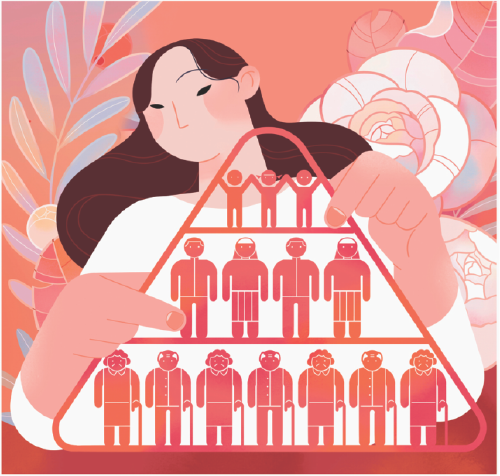
SONG CHEN/CHINA DAILY
Editor's Note: The latest official data showed the number of new births on the Chinese mainland in 2021 was 10.62 million, compared with about 12 million in 2020, and the fertility rate declined to a record low of 7.52 births per 1,000. Three scholars from the Republic of Korea, Japan and China shared their views on the common challenge of aging society at a recent forum held by the China Institute for Reform and Development. Below are excerpts from the three scholars' speeches:
Policies needed to raise fertility rate
The numbers of senior citizens have grown dramatically in China, Japan and the ROK in recent years. Those aged 65 or above accounted for 16.5 percent in the ROK, 13.5 percent in China and 28.5 percent in Japan. And the fertility rates are 0.84 in the ROK, 1.34 in Japan, and 1.7 in China. The low birth rates have led to a decline in the labor force-people aged between 15 and 64-in the three countries.
An aging society and low fertility rate will affect a country's economic growth and increase its fiscal deficit, and it is estimated that the potential growth rates of the three countries will also drop mainly because of the declining fertility rates. The aging population poses a big challenge to a country's welfare system and may aggravate the government's debt burden.
The decline in the birth rate in the ROK can be attributed to three factors. First, the population of women of childbearing age is declining. But fortunately, the population of women in their 20s has slightly increased, which means the fertility rate could increase in the ROK in the future. Second, since most of the women of childbearing age in the ROK have higher education degrees, they tend to marry at a later age. And third, the high housing prices discourage people to get married, and even if they do so, not to have children.
To encourage couples to have more children, the governments of China, Japan and the ROK have implemented various favorable policies. In the ROK, for example, the authorities provide financial assistance for pregnant women and elderly people who do not get enough pension. Some have suggested raising the retirement age, but that would reduce the scope of young people's employment.
So the three countries should take measures to encourage youths to get married and have children, for which they have to reduce housing and education costs, and ensure people are covered by endowment insurance. The three countries' governments should also help solve people's financial problems rather than just introducing temporary pronatalist policies.
Kim Jung-Sik, professor emeritus at the School of Economics, Yonsei University
Declining effects of monetary policy
Although Japan has implemented financial and monetary policies to create new jobs and revive the economy, the policies have not benefited older people who rely on pensions and social welfare. Once the population of senior citizens accounts for 25 percent of a country's population, the effects of monetary policies will be reduced sharply.
But if older and younger workers are skillful enough to complement each other, they can jointly contribute to the economic recovery of their country. In this regard, Japan is applying robots in as many sectors as possible, as well as encouraging retirees and housewives to rejoin the labor market.
Naoyuki Yoshino, professor emeritus, Keio University, and director of the Financial Research Center, Financial Service Agency Government of Japan
Low birthrate is a matter of concern
Two regions are especially witnessing significant declining birthrates and accelerating aging at the same time, including China, Japan, and the ROK in East Asia, and Western and Northern Europe. France was the first country that reported a dramatically low fertility rate, though the situation in the country has been improving.
In East Asia, the ROK and China, like Japan, have seen their fertility rates declining. After the end of World War II, some countries experienced a baby boom, although Japan and China experienced baby booms at different times. Yet China, Japan and the ROK all face the common problem of an aging society because of rising life expectancy and declining fertility rates.
China's aging population is growing rapidly, with people in rural areas aging faster than their urban counterparts. So, the government needs to formulate policies in accordance with the national conditions.
In an aging society, eldercare costs are high, labor force participation in overall productivity is low and family size relatively small. For example, more than 100 million elderly people in China live alone, some of whom are childless, with many others living separately from their adult children, which means they need special care.
After the launch of reform and opening-up in 1978, population growth contributed 25-28 percent to China's GDP. But China has been losing its demographic dividend for the past few years, and the falling birthrate has led to a shortage of effective demand, leading to an economic slowdown.
It is necessary to identify and analyze the problems caused by low fertility rates. From a macro perspective, there is a need to reconsider the threshold of "old age", especially since China's life expectancy has reached 79. In fact, China, like Japan, may raise the retirement age or delay the pension-claim period.
Yet the authorities should also deepen policy reform, further ease the family planning policy, and ensure that parents decide how many children they want to have.
Moreover, the government needs to intensify reforms in the housing, healthcare and education sectors, by imposing higher property tax or fines on people who violate housing regulations, and ensure everyone gets access to medical treatment.
Given that more than 85 percent of the elderly population in China stay at home, the government needs to deepen the pension insurance reform.
(Tian Xueyuan, a member of the Chinese Academy of Social Sciences.The views don't necessarily represent those of this platform.)






